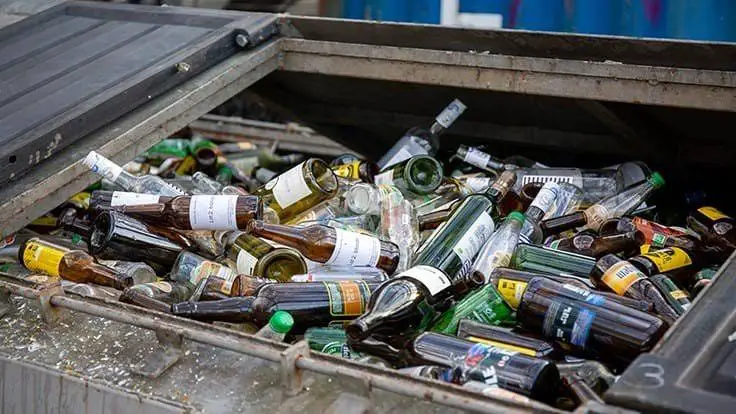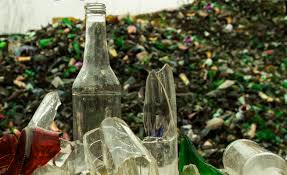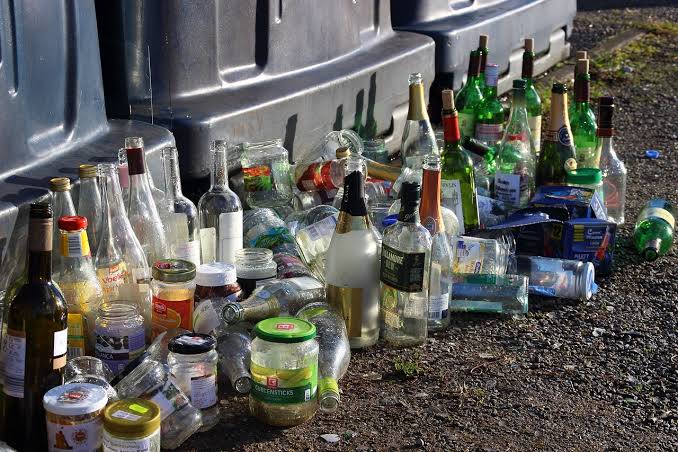The Steps to Convert Glass Wastes into New Glass Containers: We can change glass waste into fresh glass containers. When we use glass things like bottles or jars, we sometimes throw them away. But instead of throwing them, we can make them into new glass stuff. It’s like giving old things a new life.
Glass is special because it can be used over and over again. Unlike some other materials, it doesn’t lose its quality when we recycle it. This means we can keep using it without worrying about it getting weaker or not working as well.
First, we collect the old glass. This means picking up used glass bottles or jars from places like homes or businesses. Then, we sort them out. Sorting means putting them into groups based on their color. Some glass is clear, some green, and some brown. Sorting helps us make sure we use the right glass for making new containers.
Next, we clean the glass. We wash away any dirt or labels stuck on them. Clean glass is important because it helps make new containers that look nice and work well.
After cleaning, we crush the glass into tiny pieces. Crushing makes it easier to melt. Then, we melt the crushed glass in a big oven called a furnace. Melting makes the glass soft and liquidy, like hot lava.
Once the glass is melted, we pour it into molds. Molds are like special containers that shape the glass into new containers. We can make different shapes and sizes depending on what people need.
After the glass cools down and hardens, we have brand new containers ready to use. These containers are just as good as ones made from new materials. Plus, by using old glass, we help the environment by reducing waste and saving energy.
So, by converting glass waste into new glass containers, we not only get useful things but also take care of our planet. It’s a win-win!
Read Also: The Ultimate Guide to Unlocking the Potential of Garbage Wastes
Types of Recyclable Glass Wastes and their Uses

There are different types of recyclable glass wastes, each with its own uses:
1. Clear Glass: Clear glass is often used for products like bottles and jars for foods and beverages. When recycled, it can be turned into new clear glass containers, such as bottles for juices, water, or sauces.
2. Green Glass: Green glass is commonly used for items like wine bottles and some types of beverage bottles. When recycled, it can be used to make more green glass containers, including bottles for wine, beer, and other beverages.
3. Brown Glass: Brown glass is often used for containers for products like beer, certain types of sauces, and medicine bottles. When recycled, it can be turned into new brown glass containers, such as bottles for beer, vinegar, or pharmaceuticals.
4. Blue Glass: Blue glass is less common but is used for some specialty bottles, like those for certain types of liquor or cosmetic products. When recycled, it can be transformed into new blue glass containers, such as decorative bottles or containers for specialty products.
5. Mixed Glass: Sometimes, glass waste is mixed together, containing various colors. While this can make recycling a bit more challenging, it can still be melted down and used to create new glass products. This mixed glass is often used for items like fiberglass insulation, road aggregate, or even new glass containers with a mixed-color aesthetic.
Overall, the different types of recyclable glass wastes can be melted down and repurposed into a variety of new products, helping to conserve resources, reduce waste, and protect the environment.
How to Convert Glass Wastes into New Glass Containers

Converting glass wastes into new glass containers involves several steps:
1. Collection: First, we gather used glass items like bottles and jars from homes, businesses, and recycling centers. It’s important to collect clean glass without contaminants like food residue or other materials.
2. Sorting: Next, the collected glass is sorted by color. Clear, green, brown, and other colored glass are separated because different colors require different chemical compositions. This sorting ensures that the recycled glass maintains its original color and quality.
3. Cleaning: The sorted glass is thoroughly cleaned to remove any labels, caps, or other impurities. Washing the glass ensures that only clean material enters the recycling process, resulting in high-quality recycled glass products.
4. Crushing: After cleaning, the glass is crushed into small pieces called cullet. Crushing reduces the glass into uniform particles, making it easier to melt and remold into new containers.
5. Melting: The crushed glass cullet is then fed into a furnace and melted at high temperatures. The furnace heats the glass to its melting point, turning it into a molten liquid. This molten glass can be shaped into new containers or other glass products.
6. Forming: Once melted, the glass is shaped into molds to create new containers. The molten glass is poured into molds of various shapes and sizes, depending on the desired end product. The glass is allowed to cool and solidify within the molds.
7. Annealing: After forming, the newly shaped glass containers undergo a process called annealing. This involves slowly cooling the glass to relieve internal stresses and strengthen the containers. Annealing ensures that the glass containers are durable and resistant to breakage.
8. Quality Control: Throughout the recycling process, quality control measures are implemented to ensure that the recycled glass meets industry standards. Inspections are conducted to check for defects, imperfections, or impurities that could affect the quality of the final products.
By following these steps, glass wastes can be successfully converted into new glass containers, reducing the need for virgin materials, conserving energy, and minimizing environmental impact.
The Benefits of Converting Glass Wastes into New Glass Containers
Converting glass wastes into new glass containers offers numerous benefits:
1. Resource Conservation: Recycling glass reduces the need for raw materials like sand, soda ash, and limestone, which are used to make new glass. By repurposing existing glass, we conserve natural resources and minimize the environmental impact of glass production.
2. Energy Savings: Producing glass from recycled materials requires less energy than manufacturing glass from scratch. Melting recycled glass cullet in furnaces consumes less energy compared to the high temperatures needed to melt raw materials. This energy efficiency helps reduce greenhouse gas emissions and combat climate change.
3. Waste Reduction: Recycling glass waste diverts it from landfills, where it would otherwise occupy valuable space and contribute to environmental pollution. By recycling glass, we decrease the amount of waste sent to landfills and promote a more sustainable waste management system.
4. Economic Benefits: Recycling glass creates jobs in collection, sorting, processing, and manufacturing sectors. Additionally, using recycled glass in manufacturing reduces production costs for glass containers, making them more economically competitive in the market. This economic activity contributes to local economies and stimulates growth in recycling industries.
5. Preservation of Landscapes: Sand mining, a primary source of raw material for glass production, can lead to habitat destruction, erosion, and landscape degradation. By recycling glass, we reduce the demand for virgin sand extraction, helping preserve natural landscapes and ecosystems.
6. Reduction of Air and Water Pollution: Glass manufacturing processes, particularly the production of raw materials and the melting of glass, can release pollutants into the air and water. By recycling glass and minimizing the need for new glass production, we mitigate air and water pollution, leading to cleaner environments and improved public health.
7. Promotion of Circular Economy: Recycling glass fosters a circular economy model where materials are continuously reused, reducing the reliance on finite resources and minimizing waste generation. By closing the loop on glass packaging, we create a sustainable cycle of production, consumption, and recycling.
Overall, converting glass wastes into new glass containers offers a multitude of environmental, economic, and social benefits, contributing to a more sustainable and resource-efficient society.
Read Also: How to Choose the Right Trash Service for Your Needs
The Uses and Benefits of Recycled New Glass Containers

Recycled new glass containers offer various uses and benefits:
1. Packaging: Recycled glass containers are commonly used for packaging various products such as beverages, sauces, condiments, and cosmetics. They provide a sustainable alternative to single-use plastic containers and help reduce plastic pollution.
2. Food Preservation: Glass containers are inert and impermeable, making them ideal for preserving food freshness and flavor. Recycled glass jars and bottles are commonly used for storing jams, pickles, sauces, and other homemade or commercial food products.
3. Beverage Storage: Recycled glass bottles are widely used for packaging beverages such as water, juices, soft drinks, beer, wine, and spirits. Glass containers help maintain the taste, purity, and quality of beverages without imparting any unwanted flavors.
4. Environmental Benefits: Using recycled glass containers reduces the demand for new glass production, conserving natural resources, and minimizing energy consumption and greenhouse gas emissions. By choosing recycled glass products, consumers contribute to environmental conservation and sustainable resource management.
5. Durability: Recycled glass containers are durable and resistant to corrosion, ensuring product integrity during storage and transportation. They can withstand temperature changes, making them suitable for both hot and cold beverages and foods.
6. Aesthetic Appeal: Recycled glass containers often have a unique appearance with slight variations in color and texture, adding aesthetic appeal to products on store shelves. Many consumers appreciate the rustic, vintage, or eco-friendly look of recycled glass packaging.
7. Versatility: Recycled glass containers come in various shapes, sizes, and designs, offering versatility in packaging options. They can be customized with labels, seals, and closures to meet the specific branding and marketing requirements of different products.
8. Recyclability: Glass is infinitely recyclable, meaning it can be recycled repeatedly without losing quality or purity. Recycled glass containers can be collected, processed, and melted down to create new glass products, closing the loop on the recycling process and promoting a circular economy.
Overall, recycled new glass containers offer a range of uses and benefits, including sustainable packaging, environmental conservation, product preservation, aesthetic appeal, and recyclability. Choosing recycled glass products supports a greener, more sustainable future for packaging and consumer goods industries.
The Challenges of Converting Glass Wastes into New Glass Containers and their Solutions
Converting glass wastes into new glass containers poses several challenges, along with potential solutions:
1. Contamination: Glass waste collected for recycling may contain contaminants such as food residue, labels, and caps, which can affect the quality of the recycled glass. Solution; Implement thorough cleaning and sorting processes to remove contaminants before recycling. This can involve washing, rinsing, and separating glass by color to ensure high-quality recycled glass.
2. Color Sorting: Different colors of glass require separate recycling processes due to their varying chemical compositions. Sorting glass by color adds complexity to the recycling process. Solution; Invest in advanced sorting technologies, such as optical sorting machines, that can efficiently separate glass by color. This improves the accuracy and speed of color sorting, enhancing the quality of recycled glass.
3. Transportation Costs: Glass is heavy and bulky, increasing transportation costs for collecting and transporting glass waste to recycling facilities. Solution; Optimize collection routes and logistics to minimize transportation distances and fuel consumption. Establish regional recycling centers to reduce transportation distances and costs for glass collection.
4. Glass Breakage: Glass waste collected for recycling may break during handling and transportation, leading to loss of material and safety hazards. Solution; Implement proper handling procedures and use durable containers or bins for collecting and transporting glass waste. Train workers in safe handling practices to minimize breakage and ensure worker safety.
5. Energy Consumption: Melting glass cullet to produce new glass containers requires significant energy input, contributing to greenhouse gas emissions and environmental impact. Solution; Invest in energy-efficient technologies, such as electric furnaces or waste heat recovery systems, to reduce energy consumption during glass recycling. Utilize renewable energy sources, such as solar or wind power, to power glass recycling facilities and further reduce environmental impact.
6. Quality Control: Ensuring the quality of recycled glass containers is essential to meet industry standards and consumer expectations. Contaminants, impurities, or defects in recycled glass can compromise product quality. Solution: Implement rigorous quality control measures throughout the recycling process, including inspections, testing, and certification. Train staff in quality assurance techniques to identify and address any issues promptly.
7. Market Demand: The market demand for recycled glass containers may fluctuate due to factors such as changes in consumer preferences, economic conditions, and competition from alternative packaging materials. Solution; Diversify product offerings and explore new markets for recycled glass containers, such as eco-friendly packaging solutions for sustainable brands and industries. Collaborate with businesses and organizations to raise awareness of the benefits of recycled glass and stimulate demand for recycled glass products.
By addressing these challenges with innovative solutions and best practices, the conversion of glass wastes into new glass containers can become more efficient, cost-effective, and sustainable, contributing to a circular economy and environmental conservation efforts.
Frequently Asked Questions (FAQs) About How to Convert Glass Wastes into New Glass Containers
1. Q: What types of glass can be recycled to make new glass containers?
A: Clear, green, brown, blue, and mixed-colored glass can all be recycled to produce new glass containers. It’s important to separate them by color during the recycling process.
2. Q: How is glass waste collected for recycling?
A: Glass waste is collected from various sources such as homes, businesses, and recycling centers. It’s important to collect clean glass without contaminants like food residue or other materials.
3. Q: What happens to glass waste after it’s collected for recycling?
A: Glass waste goes through a series of steps including sorting, cleaning, crushing, melting, forming, and annealing to convert it into new glass containers. These processes ensure that the recycled glass maintains its quality and purity.
4. Q: Why is color sorting important in glass recycling?
A: Different colors of glass have different chemical compositions, so they need to be separated during recycling to ensure the quality of the recycled glass. Color sorting helps maintain the integrity and color consistency of the final glass products.
5. Q: How energy-intensive is the process of converting glass waste into new glass containers?
A: Melting glass cullet to produce new glass containers requires significant energy input, but using recycled glass consumes less energy compared to manufacturing glass from raw materials. Energy-efficient technologies and renewable energy sources can help minimize the environmental impact of glass recycling.
6. Q: Are there any challenges or obstacles in converting glass waste into new glass containers?
A: Yes, challenges such as contamination, transportation costs, glass breakage, and quality control issues can arise during the glass recycling process. However, these challenges can be addressed with proper handling procedures, advanced sorting technologies, quality control measures, and energy-efficient practices.
7. Q: How can individuals contribute to glass recycling efforts?
A: Individuals can contribute to glass recycling efforts by properly sorting and disposing of glass waste in designated recycling bins, reducing glass waste by reusing glass containers, and supporting businesses and industries that use recycled glass packaging. Additionally, raising awareness about the importance of glass recycling and advocating for sustainable practices can help promote glass recycling initiatives.
Read Also: Are Honey Bees Endangered?

